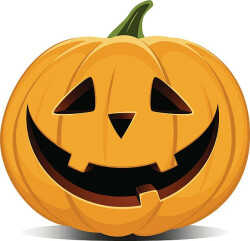
This evening some children and even adults will don costumes and join the festivities of Halloween. Few will know of its ancient Celtic roots in the Samhain festival (pronounced saa-wn). Two thousand years ago in Celtic Ireland, Samhain was the division of the year between the lighter half (summer) and the darker half (winter). On this night the division between this world and the otherworld was believed to be at its thinnest, allowing spirits to pass through. Families welcomed and honored their ancestors, but felt the need to ward off harmful spirits, wearing costumes and masks to disguise themselves against harm.
The two days after All Hallows’ Eve are All Saints' Day (November 1) and All Souls' Day (November 2) which, by the way, did not evolve from paganism. But Christianity incorporated honoring the dead into the Christian calendar with All Saints (All Hallows) followed by All Souls Day. Altogether, the three-day observance is called “Allhallowtide.” All Saints' Day commemorates saints and martyrs throughout Christian history. All Souls' Day commemorates everyone who has passed away within the faith.
Wearing costumes and masks survived to our present day as Halloween costumes. Many Irish immigrated to America during the 19th century, especially during the potato famine in the 1840's. They brought this ancient tradition to America, and today Halloween is one of the major annual parties, though admittedly with a completely different emphasis.
Many Halloween traditions date from 15th century Western Europe. While their original meanings are largely lost, some customs have survived to this day. Going costumed from door to door to ask for treats dates back to the early All Souls’ Day festivities in England. Poor citizens would beg for food, and families would give them pastries called “soul cakes” in exchange for their promise to pray for the family’s dead relatives. This was actually encouraged by churches as a way to replace the ancient practice of leaving food and wine for returning spirits on Halloween night. Trick-or-treating is the carry-over to our present day, popular in the US since the early 20th century.
People have been making jack-o’-lanterns on Halloween for centuries, but not always out of pumpkins. The earliest were carved from turnips, potatoes, or beets. This originated from an Irish myth about a man named Stingy Jack…and all these centuries later there are many iterations of that myth to be found on the internet.
For Christians today, All Hallows’ Eve can be a time to remember and celebrate the work God has done in and through His saints. Like many others, our church embraces Halloween as a community outreach opportunity offering a safe and fun experience with darker themes removed. It’s one more way we can “press on toward the goal for the prize of the upward call of God in Christ Jesus.” (Philippians 3:14).
“Behold, I have given you authority to tread on serpents and scorpions, and over all the power of the enemy, and nothing shall hurt you. Nevertheless, do not rejoice in this, that the spirits are subject to you, but rejoice that your names are written in heaven.” – Luke 10:19-20.
